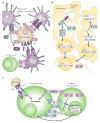Genetic susceptibility to SLE: new insights from fine mapping and genome-wide association studies
- PMID: 19337289
- PMCID: PMC2737697
- DOI: 10.1038/nrg2571
Genetic susceptibility to SLE: new insights from fine mapping and genome-wide association studies
Abstract
Genome-wide association studies and fine mapping of candidate regions have rapidly advanced our understanding of the genetic basis of systemic lupus erythematosus (SLE). More than 20 robust associations have now been identified and confirmed, providing insights at the molecular level that refine our understanding of the involvement of host immune response processes. In addition, genes with unknown roles in SLE pathophysiology have been identified. These findings may provide new routes towards improved clinical management of this complex disease.
Figures


References
-
- Lau CS, Yin G, Mok MY. Ethnic and geographical differences in systemic lupus erythematosus: an overview. Lupus. 2006;15:713–714. - PubMed
-
- Lockshin MD. Sex differences in autoimmune disease. Lupus. 2006;15:753–756. - PubMed
-
- Uribe AG, McGwin G, Jr, Reveille JD, Alarcon GS. What have we learned from a 10-year experience with the LUMINA (Lupus in Minorities; nature vs Nurture) cohort? Where are we heading? Autoimmun Rev. 2004;3:321–329. - PubMed
-
- Hochberg MC. Updating the American College of Rheumatology revised criteria for the classification of systemic lupus erythematosus. Arthritis Rheum. 1997;40:1725. - PubMed
-
- Tan EM, Cohen AS, Fries JF, Masi AT, McShane DJ, et al. The 1982 revised criteria for the classification of systemic lupus erythematosus. Arthritis Rheum. 1982;25:1271–1277. - PubMed
Publication types
MeSH terms
Grants and funding
- AR49084/AR/NIAMS NIH HHS/United States
- P30 AR053483/AR/NIAMS NIH HHS/United States
- AI24717/AI/NIAID NIH HHS/United States
- R01 AI024717/AI/NIAID NIH HHS/United States
- HD07463/HD/NICHD NIH HHS/United States
- GM063483/GM/NIGMS NIH HHS/United States
- P01 AR049084/AR/NIAMS NIH HHS/United States
- AR42460/AR/NIAMS NIH HHS/United States
- T32 HD007463/HD/NICHD NIH HHS/United States
- N01 AR062277/AR/NIAMS NIH HHS/United States
- T32 GM063483/GM/NIGMS NIH HHS/United States
- R37 AI024717/AI/NIAID NIH HHS/United States
- R01 AR042460/AR/NIAMS NIH HHS/United States
LinkOut - more resources
Full Text Sources
Other Literature Sources
Medical

